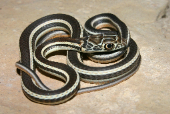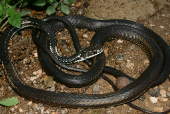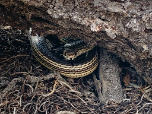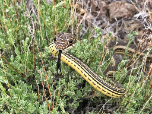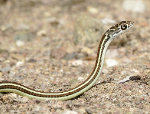Striped Whipsnake (Masticophis taeniatus)
Description: The striped whipsnake is approximately 30-72 inches in total length (including tail). This snake exhibits black, dark brown, or gray coloration on its back, often with an olive or bluish tint. Along the center of each of the first four rows of pale dorsal scales, is a dark longitudinal stripe. There is a white to cream-colored stripe down its side that is bisected by either a solid or dashed black line. The coloring on the snake's belly tends to be cream to yellowish, fading to white toward the head, and coral pink toward the tail. This snake also features a lower preocular between the upper labial scales of the mouth. The anal scale is divided.
Habitat: The striped whipsnake is commonly found in a wide variety of habitats including shrublands, grasslands, sagebrush flats, canyons, piñon-juniper woodlands, and open pine-oak forests. It is attracted to both permanent and seasonal rocky streams, and it frequents both flatlands and mountains.[c
Range: The striped whipsnake is found throughout the western United States and northern Mexico. The northernmost part of its geographic range is in south central Washington, and continues southward into the Great Basin between the Cascade-Sierran crest and the continental divide. Its range then continues southeast across the continental divide into New Mexico and western and central Texas. The southernmost part of its range lies in Michoacán, Mexico. In the Western United States its range also extends outside of the Great Basin into the Rogue River Valley in southwestern Oregon and northern California. There is a population in Bryce Canyon National Park in Utah.
Diet: This snake is nonvenomous, but it preys on a wide variety of species including lizards, other snakes (including venomous rattlesnakes), small mammals, young birds, frogs, and insects.
Reproduction: The striped whipsnake is oviparous. Little is known about the reproductive activities of M. taeniatus. After fertilization the female striped whipsnake will lay a clutch of 3-12 eggs, between the months of June and July, usually in an abandoned rodent burrow.
Status: Listed as Least Concern in view of the large and probably relatively stable extent of occurrence, area of occupancy, number of subpopulations, and population size. There are no major threats known.
»» Kingdom: Animalia - Animals
»» Phylum: Chordata - Chordates
»» Subphylum: Vertebrata - Vertebrates
»» Class: Reptilia - Reptiles
»» Order: Squamata - Scaled Reptiles
»» Suborder: Serpentes
»» Superfamily: Colubroidea
»» Family: Colubridae - Colubrids
»» Genus: Masticophis
»» Species: Masticophis taeniatus - Striped Whipsnake
This article uses material from the Wikipedia article "Striped Whipsnake", which is released under the Creative Commons Attribution-Share-Alike License 3.0. Content may have been omitted from the original, but no content has been changed or extended.
|


